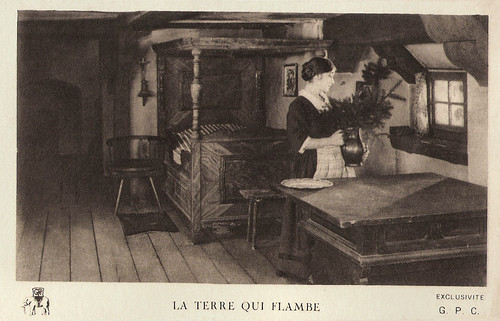
French postcard by Edition de la Cinématographie Française, Paris. Photo: G.P.C. Publicity still for Der brennende Acker/Burning Soil/La terre qui flambe (Friedrich Wilhelm Murnau, 1922). Maria (Grete Diercks) works in the household of Peter Rog and his father. Peter is in love with her and wants to marry her, but she instead loves his younger brother Johannes.
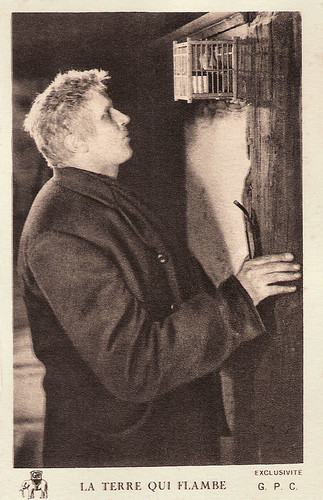
French postcard by Edition de la Cinématographie Française, Paris. Photo: G.P.C. Publicity still for Der brennende Acker/Burning Soil/La terre qui flambe (Friedrich Wilhelm Murnau, 1922) with Eugen Klöpfer as Peter Rog.
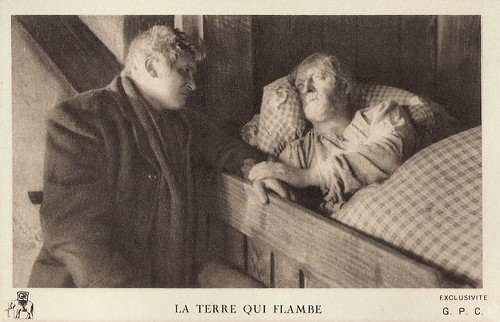
French postcard by Edition de la Cinématographie Française, Paris. Photo: G.P.C. Publicity still for Der brennende Acker/Burning Soil/La terre qui flambe (Friedrich Wilhelm Murnau, 1922). Peter Rog (Eugen Klöpfer) takes care of his dying father (Werner Krauss).
The Devil's Field
Der brennende Acker presents two households: that of the wealthy Count Josef Emmanuel of Rudenberg and the Rogs, a fairly prosperous farm family who live nearby.
When the old farmer Rog (Werner Krauss) dies, his hard-working son Peter (Eugen Klöpfer) attends him and stays at the farm after his father's death.
The other, younger son is the more worldly Johannes (Vladimir Gajdarov). He has great ambitions and he refuses the love of the servant Maria (Grete Diercks).
His ambition leads the handsome Johannes to charm Gerda (Lya de Putti), the daughter of the old Count Rudenberg (Eduard von Winterstein), who is also dying. Gerda helps Johannes to a job as the secretary of the Count.
Johannes discovers that the Count's second wife Helga (Stella Arbenina) will inherit the Devil's Field. Only he knows that the land sits on an untapped oil field worth a fortune.
Joahnnes turns his attention from Gerda to Helga. When she is widowed, he marries her. His greed leads to death and burning soil.
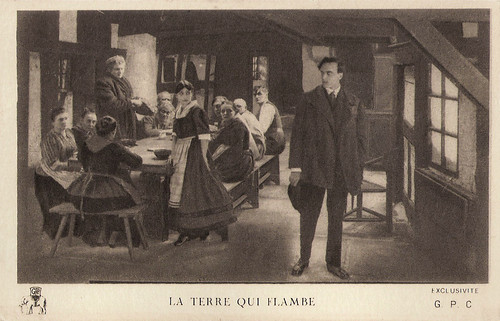
French postcard by Edition de la Cinématographie Française, Paris. Photo: G.P.C. Publicity still for Der brennende Acker/Burning Soil/La terre qui flambe (Friedrich Wilhelm Murnau, 1922). At the farm of the Rog family. The housemaid Maria (Grete Diercks) eyes Johannes Rog (Vladimir Gajdarov), but he is only interested in money.
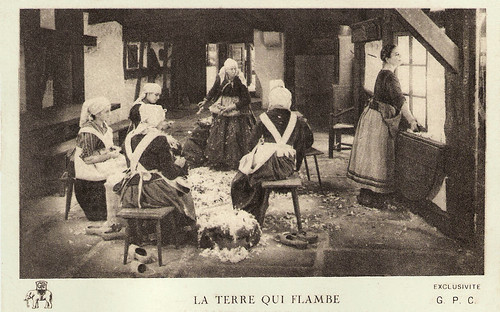
French postcard by Edition de la Cinématographie Française, Paris. Photo: G.P.C. Publicity still for Der brennende Acker/Burning Soil/La terre qui flambe (Friedrich Wilhelm Murnau, 1922) with Grete Diercks as the housemaid Marie.
Friedrich Wilhelm Murnau
In the 1920s Friedrich Wilhelm Murnau (1888-1931) was with Fritz Lang and G. W. Pabst one of the three great German film directors. Sandra Brennan at AllMovie writes that "To this day German filmmaker F.W.Murnau remains one of the most influential directors of cinema."
He made his directorial debut in 1919, the fantasy film Der Knabe in Blau/Emerald of Death (1919). His next films were also fantasy films: The three-part Satanas/Satan (1919), Murnau's first film with cinematographer Karl Freund and leading actor Conrad Veidt, and Der Bucklige und die Tänzerin/The Hunchback and the Dancer (1920), that marked the start of Murnau's collaboration with screenplay writer Carl Mayer.
With Schloss Vogelöd/The Haunted Castle (1921), filmed in only 16 days, Murnau already proved his ability to create an atmosphere of fear and horror, an ability that he masterly refined in Der Brennende Acker (1922) and his famous vampire film Nosferatu – Eine Symphonie des Grauens/Nosferatu, a Symphony of Horror (1922).
His next film, Der letzte Mann/The Last Laugh (1924), utilized unique camera techniques that later became the basis for mise-en-scene. For this film, Karl Freund masterly operated the 'moving camera'. Besides Der letzte Mann, Murnau's literary adaptations Tartüff/Tartuffe (1925) and Faust (1925/26) also rank among the classic films of Weimar cinema produced by Erich Pommer.
In 1926, Murnau moved to Hollywood to work for Fox studios. His first American film, Sunrise: A Story of Two Humans (1927), is considered to be the apex of German silent cinema and won an Academy Award for its artistic quality. His second American film Four Devils (1928) was turned into a happy ending and was equipped with a soundtrack. The same happened to Our Daily Bread/City Girl (1929-1930).
Murnau returned to Berlin but his negotiations with Ufa did not lead to a result. In 1929, he travelled to Tahiti where he made the naïve love story Tabu (1931) at his own expense. Deep in debt, he returned to Hollywood, where Paramount offered him a ten-year contract. Tabu became a box-office hit, but the week before it opened, F.W. Murnau was killed in an auto accident. He was only 42.
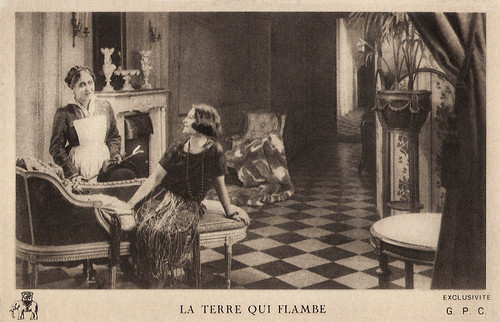
French postcard by Edition de la Cinématographie Française, Paris. Photo: G.P.C. Publicity still for Der brennende Acker/Burning Soil/La terre qui flambe (Friedrich Wilhelm Murnau, 1922). Gerda (Lya de Putti) and her maid (Leonie Taliansky).
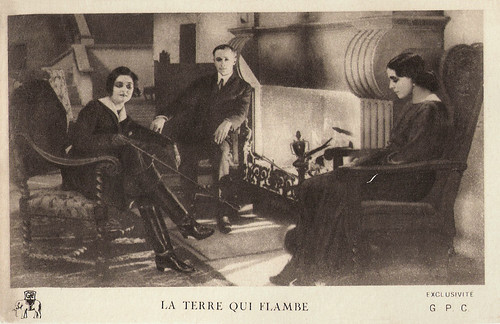
French postcard by Edition de la Cinématographie Française, Paris. Photo: G.P.C. Publicity still for Der brennende Acker/Burning Soil/La terre qui flambe (Friedrich Wilhelm Murnau, 1922). Count Rudenburg (Eduard von Winterstein), flanked by, left, his daughter Gerda (Lya de Putti), and right, his second wife Helga (Stella Arbenina).
Der brennende Acker
Der brennende Acker/Burning Soil or in French La terre qui flambe was considered lost for a long time. Until 1978 only the last three reels (totalling 843 meters compared to the original 2,645) of the film were known: this was the black-and-white copy preserved by the East German Cinematheque. In 1979, an almost complete copy of the film was identified only by film historian Vittorio Martinelli at the Cineteca Italiana in Milan. It was a version distributed in Italy under the title 'Il campo del diavolo' (The Devil's Field) whose opening credits and captions in Italian had certainly been made in Italy and whose images were developed in Germany. The copy belonged to a small collection of an Italian religious man who worked in institutions for the mentally ill and entertained the sick by showing old films.
Enno Patalas, director of the Münchener Filmmuseum, obtained an early black-and-white copy from a negative made in Milan: the Italian captions were replaced in Munich with new German titles from the script in the possession of F.W. Murnau's niece. From the early 1980s, this "lost" film was thus once again visible in Germany. However, a colour original still existed in Milan: with the collaboration of the Cineteca Italiana, the Bundesarchiv in Koblenz received the original material on which it was able to begin restoration work.
Having found the original censorship visa of 25 February 1922 with the text of all the captions, it was possible for the Münchener Filmmuseum to reconstruct the captions and inserts (the newspaper pages, letters, will, etc.) with the collaboration of the Pfenninger laboratory. In the absence of a model for the exact layout of the captions, inspiration was taken from other German films of the early 1920s, using dark green as the colour of the captions and light yellow as the colour of the inserts. The restored, colour version of Der brennende Acker was internationally first presented at the festival 'Il Cinema Ritrovato' in Bologna in November 1993.
Helmut Regel in the catalogue of 'Il Cinema Ritrovato', November 1993: "If the Milan copy had a length, including the Italian captions, of 2,346 meters, the new colour negative after the insertion of the new captions measures 2,325 meters. A missing sequence from a copy in the Moscow Gosfilmofond was, in addition, inserted. It is thus 320 meters short of the original footage of the copy intended by the censors (2,645 meters). In September 1993 the Bundesarchiv-Filmarchiv finished the restoration at the ABC & Taunus laboratory in Wiesbaden, resulting in a final print that comes enormously close to the original colours of the nitrate print. Finally, the long odyssey of a reconstruction had reached its end."
Der brennende Acker was acclaimed for its visual quality and the contrast between the simple rustic farm and the airy and elegant castle. Thorkell A. Ottarsson at IMDb: "The film is quite dramatic and dark, even surprisingly dark at times. A superb film from one of the best directors of all time." To achieve his visual effects, innovative camera angles, and bold lighting, Murnau had two of the most renowned cameramen photograph the film. Fritz Arno Wagner filmed the first part and Karl Freund the second part, and the sets were built by the equally renowned Rochus Gliese. Karl Freund, who began as a projectionist in Berlin and newsreel cameraman, worked for Ufa in the 1920s and gained the international reputation of being a master cameraman. His later credits include such classics as Metropolis, Der lezte Mann/The Last Laugh, Der Golem/The Golem and Variété/Variety.
W. Morrow at IMDb describes beautifully his fascination for Der brennende Acker: "a sustained mood of wintry melancholy, perked by a number of understated but impressive directorial touches. There's business involving a document torn into little pieces that is poetic. When Murnau was at his peak, in such films as Faust and Sunrise, he would stage his effects on a much grander scale, but here he manages to create a beautiful moment with a few torn pieces of paper."
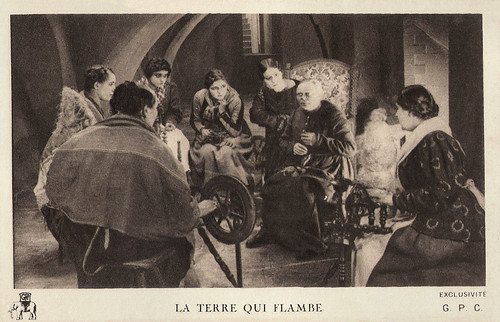
French postcard by Edition de la Cinématographie Française, Paris. Photo: G.P.C. Publicity still for Der brennende Acker/Burning Soil/La terre qui flambe (Friedrich Wilhelm Murnau, 1922). The old maid talks to the young servants about the Devil's Field.
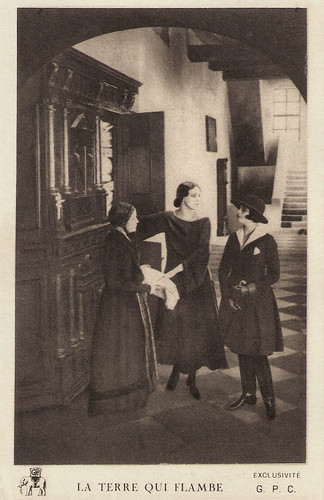
French postcard by Edition de la Cinématographie Française, Paris. Photo: G.P.C. Publicity still for Der brennende Acker/Burning Soil/La terre qui flambe (Friedrich Wilhelm Murnau, 1922). Helga, Count Rudenburg's second wife (Stella Arbenina), and Gerda, the Count's daughter (Lya de Putti), in a fierce get-together.
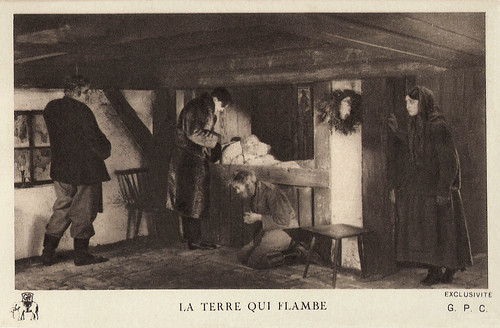 French postcard by Edition de la Cinématographie Française, Paris. Photo: G.P.C. Publicity still for Der brennende Acker/Burning Soil/La terre qui flambe (Friedrich Wilhelm Murnau, 1922). Johannes Rog (Vladimir Gajdarov) arrives too late at the deathbed of his father (Werner Krauss), while, left, his brother Peter (Eugen Klöpfer), and right, the maid Maria (Grete Diercks), look on.
French postcard by Edition de la Cinématographie Française, Paris. Photo: G.P.C. Publicity still for Der brennende Acker/Burning Soil/La terre qui flambe (Friedrich Wilhelm Murnau, 1922). Johannes Rog (Vladimir Gajdarov) arrives too late at the deathbed of his father (Werner Krauss), while, left, his brother Peter (Eugen Klöpfer), and right, the maid Maria (Grete Diercks), look on.Sources: Helmut Regel (article 'Der brennende Acker', in the catalogue Il Cinema Ritrovato, November 1993; text reused on Italian Wikipedia), Sandra Brennan (AllMovie), John DeBartolo (Silents are Golden), W. Morrow (IMDb), Thorkell A. Ottarsson (IMDb), Yepok (IMDb), Filmportal.de (German), Wikipedia (German) and IMDb.
This post was last updated on 3 July 2022.
2 comments:
Great sets. The design reminds me of Citizen Kane.
Thanks. I totally agree, there is absolutely a link between Murnau and Welles. The sets of another early Murnau film, Schloss Vögelöd, also remind me strongly of Welles' expressive sets and camera work. Both perfectly showed the loneliness of their characters living in posh castles.
Post a Comment